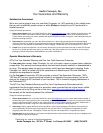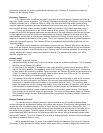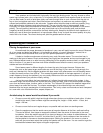
8
Hookup
Your speakers are furnished with high quality five-way type binding posts. You may choose to utilize
spade lugs, banana jacks, pins, or bare wire. It is important that the positive and negative leads do not touch. If
you use bare leads, be sure to twist them tightly and insert through holes in such a manner that they do not
fray or short out against each other. Good connections are important, so make sure any ends are tightly
crimped and preferably soldered to the wire ends. Speaker wires should be kept as short as possible, (long
wires add excessive resistance and color the sound.) The use of quality wire is recommended. Audio
Concepts, Inc. stocks and recommends DH-Labs cables. Make sure you hookup the speakers in the correct
polarity. The red (positive) terminal on your amp should hook up to the red binding post, and the black
(negative) terminal should be connected to the black binding post. Keep this the same for both speakers in a
stereo pair, and all three front speakers in a home-theater setup. A way to check the correct polarity is to play
music with a lot of bass. The correct hookup will yield the greatest amount of bass.
Positioning your Talisman SE
Placing the speakers in your room:
As mentioned, the proper placement of speakers in your room will easily improve the sound. Because
all of our rooms and tastes are different, it is impossible to specify a “correct” placement. Instead, let us
present you with some acoustical facts, then you can optimize placement in your room.
It helps to visualize sound waves as behaving very much like water waves. The sound we hear is
made up of two types of waves. Direct sound waves come right from the speaker and are not changed in any
way. Reflected waves come to us after bouncing (diffracting) off the speaker enclosure itself, or walls, ceiling,
floor or furniture. If you want to see how much these reflected waves affect the sound, move your speakers
outside and hear the difference.
Sound waves come in different lengths; the lower the note, the longer the wave. Extreme low
frequencies such as the lowest organ pedal notes are over 60 feet long! If your room is not big enough, the
wave can’t develop fully. But the biggest problem with bass notes is the phenomenon we call standing waves.
In effect the waves more or less “pile up”. This creates big peaks and dips in the bass response. If you put a
certain frequency through the speakers, you can usually walk around the room and find places where it is very
loud, and places where you perceive virtually nothing.
Just as the room affects the bass response, so it affects the mid-treble sound of the system. In the
mid-treble range, the sound waves are shorter and have peaks and dips, most of the affects (peaks and dips)
occur from enclosure edges, furniture, walls, or the floor. The Talisman SEs present the deepest image when
placed away from walls and furniture. The shorter wavelengths of the mids and highs are more easily
absorbed than the longer wavelengths of low frequencies. This is why a bare room sounds so harsh compared
to a room with a lot of stuffed furniture, carpets, drapes, etc.
An ideal setup for sound would be achieved if you could:
• Choose a room with width, height and length dimensions that are not multiples of each other. (A cube
would be the worst!) Good numbers might be something like, height = 8 feet, width = 15 feet, and
length = 26 feet.
• Choose a room that has an irregular shape, non-parallel walls cut down on standing waves.
• Place the speakers so that the woofer cones are at irregular distances to the floor, walls and ceiling.
This can be difficult. Use a tape to measure the distance from the center of the woofer to the room
boundaries. Move the woofers around till you have cut down on the number of related distances. (You
don’t want distances like 12 and 24”, but more like 12 and 22”). Use the distance from the woofer to
the boundaries to increase or decrease bass output. Sticking the speaker in the corner or close to
walls will give more bass output than putting the speaker out into the room. You can use this to get the
best balance between bass output and upper range output.













